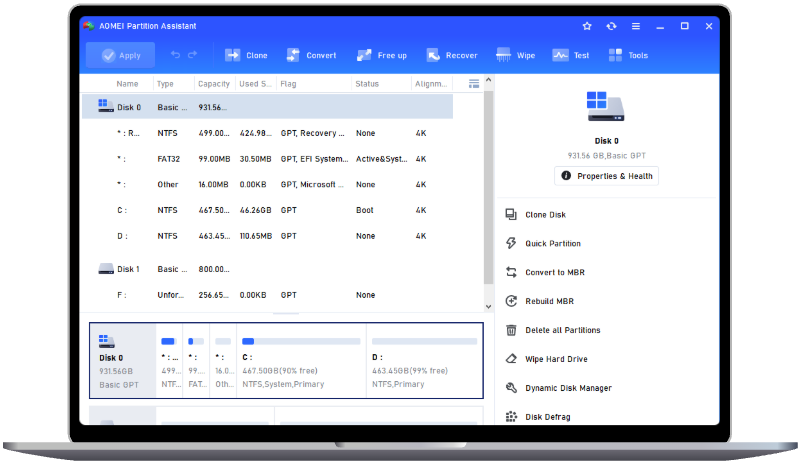How to Fix Samsung SSD Writing Super Slow on Windows 11/10 [8 Ways]
Why is my Samsung SSD writing super slow? Many reasons can be explained to it. In this article, you can also learn 8 effective ways to fix this slow speed issue on Windows 11/10.
Why is my SamsungSSDwriting superslow?
Many users encounter sluggish performance with their Samsung SSDs, particularly slow write speeds. With advancements in integrated circuit technology, SSDs have surged in popularity, significantly enhancing system performance. However, when an SSD becomes outdated or reaches full capacity, its write speed can drop dramatically, leading to frustrating slowdowns.
Regular SSD performance tests can help identify issues early. Several factors may contribute to reduced SSD write speeds in Windows 10, Windows 11, or other operating systems:
✦ Insufficient RAM
✦ AHCI mode turned off
✦ Misconfigured PC settings
✦ Malware infections affecting SSD files
✦ Incorrect boot sequence setup
✦Disabled or missing TRIM command
✦ Outdated BIOS or SSD firmware
Understanding these causes can help diagnose the Samsung SSD writing super slow problem. In the next section, explore methods to test SSD write speed and solutions to restore optimal performance.
How to test SSD write speed on Windows 10/11
If you suspect your computer’s sluggish performance is due to slow SSD write speeds, you can confirm it using Command Prompt. However, this requires entering multiple commands, which may be challenging for beginners.
For a simpler approach, third-party speed testing tools offer a more user-friendly alternative. Among the many available options, AOMEI Partition Assistant stands out as a highly effective solution.
With its Disk Speed Test feature, checking SSD write speeds becomes effortless. Even those with minimal technical experience can navigate its intuitive interface, making it easy to assess performance and manage drives efficiently.
Step 1. Install and run AOMEI Partition Assistant Professional. Click "Test" and select "Disk Speed Test".
Step 2. The Simple Mode is selected by default, you can click "Start" to begin testing.
Step 3. Or you can click "Pro Mode" to test hard drive in a comprehensive way.
Step 4. In the new window, you can change the default settings as you wish: to-be-tested Partition, Average/Maximum speed, Size, Test Number, and Duration. After everything is set, click "Start" to begin to test the hard drive read and write speed.
Step 5. When the test is done, you can see the result directly on the interface, and also you can choose to export the result to analyze later.
How to fix SamsungSSDwriting super slow on Windows 10/11
Now that you've identified issues with your SSD speed, it's time to resolve them. Below are eight effective fixes to improve SSD performance:
Fix 1. Perform 4K alignment on the slow SSD
Excessive fragmentation can significantly slow down your SSD. One effective way to restore performance is by applying 4K Alignment, which optimizes data storage and access speeds. AOMEI Partition Assistant offers a 4K Alignment feature, making it easy to enhance SSD efficiency and ensure smoother operation.
Step 1. Install and launch AOMEI Partition Assistant, select the partition that you want to align, and right-click on it. Move the cursor to “Advanced” and select “Partition Alignment” which appears on the right.
Step 2. In the popup window, set partition alignment to “4096 Sector” or you can also set it to the default one. Click on “OK” to proceed.
Note: If the partition has already been aligned, you’ll be prompted that “The current partition is already optimized thus there’s no need to align it again.
Step 3. Click on “Apply” on the upper left of the screen to start the alignment.
Fix 2. Make sure the TRIM command is running
If the TRIM command is disabled, your SSD is more likely to experience Samsung SSDslow performance. Follow these steps to check and enable TRIM on your system:
Step 1. Open Command Prompt as an administrator.
Step 2. Type the following command and press Enter:
fsutil behavior query DisableDeleteNotify
If the result is 0, TRIM is already enabled.
If the result is 1, TRIM is disabled.
Step 3. If TRIM is disabled, enable it by entering the following command and press Enter:
fsutil behavior set DisableDeleteNotify 0
Step 4. TRIM will be successfully activated, helping to maintain optimal SSD performance.
Fix 3. Enable AHCI mode
Enabling AHCI (Advanced Host Controller Interface) is essential for maximizing SSD performance, as it allows for faster data transfer compared to IDE mode. Follow these steps to enable AHCI using Command Prompt:
Step 1. Open Command Prompt as an administrator.
Step 2. Enter the following command and press Enter:
bcdedit /set {current} safeboot minimal
Step 3. Restart your PC and enter the BIOS. Locate and enable AHCI mode in the storage settings.
Step 4. Save changes and exit BIOS.
Step 5. Boot into Safe Mode and open Command Prompt again. Then, enter:
bcdedit /deletevalue {current} safeboot
Step 6. Restart your system, and Windows will automatically install AHCI drivers, enhancing SSD write speeds.
Fix 4. Disable Onboard VGA
If your Onboard VGA is enabled, it may contribute to slow SSD write speeds. Disabling it can help improve performance. Follow these steps:
Step 1. Restart your PC and enter the BIOS.
Step 2. Navigate to the Advanced BIOS section.
Step 3. Locate Onboard VGA and set it to Disable.
Step 4. Save the changes and exit BIOS.
After restarting, your system should function more efficiently, potentially improving SSD performance.
Fix 5. Choose a High-Performance mode
If your SSD isn't receiving enough power, it may not function at its full potential. Enabling High-Performance Mode ensures optimal speed and efficiency. Follow these steps:
Step 1. Open the Start Menu and search for Power.
Step 2. Click on Power & Sleep Settings.
Step 3. Select Additional Power Settings.
Step 4. Under Power Mode, choose Best Performance.
This setting prioritizes performance over power saving, allowing your SSD to operate at maximum efficiency.
Fix 6. Update Samsung Magician
To optimize and manage your Samsung SSD, you can use Samsung Magician, a tool that offers firmware updates and bug fixes. If your Samsung SSD is slowing down, ensure you have the latest version of Samsung Magician and follow these steps to update its firmware:
Step 1. Visit the Samsung website to download the latest version of Samsung Magician.
Step 2. Open the Samsung Magician application.
Step 3. Click the Update button located in the bottom left corner of the window.
Step 4. Look for the Firmware Update option for your Samsung SSD, click Update, then confirm by clicking OK.
Step 5. After the update process is complete, open Samsung Magician again to verify that the firmware has been successfully updated.
Updating the firmware should help improve your Samsung SSD’s write speed and overall performance.
Fix 7. Configure correct boot order
An incorrectly set boot sequence can lead to slow SSD performance, especially if the hard drive is prioritized over the SSD. To fix this, follow these steps to configure the correct boot order:
Step 1. Restart your computer and enter the BIOS.
Step 2. Navigate to System Configuration, then select Boot Options.
Step 3. Adjust the boot order to prioritize the SSD over the hard drive.
After saving the changes, your system should boot more efficiently, improving overall performance.
Fix 8. Free up hard drive space
You can use AOMEI Partition Assistant to free up space on your Samsung SSD effectively.AOMEI Partition Assistant is a reliable and user-friendly disk management tool for Windows, designed to make partition extension simpler and more efficient compared to other methods.
To get started, download AOMEI Partition Assistant and follow the instructions to free up space on your Samsung SSD.
Step 1. Install and run Partition Assistant, click “Free up” on in the top toolbar, and choose “App Mover”.
Step 2. All details about the disks will show in the new window, choose the SSD that you want to move programs from, and click "Next".
Step 3. Choose the programs you want to move and select the target location, then click "Move”.
Step 4. In the new pop-up window, you need to confirm closing running applications when moving starts. Click "OK" to begin the process.
After you move programs from the destination SSD successfully, your old SSD will have much free space. You can also use "Delete Large Files" to deeply clean your PC.
Conclusion
A slow SSD write speed can be incredibly frustrating, especially when gaming or working on important tasks. If left unresolved, this issue could lead to severe SSD corruption and potential data loss.
To avoid this, it’s essential to regularly monitor your SSD’s performance. AOMEI Partition Assistant makes it simple to check the SSD's speed and even improve slow write speeds. This tool is compatible with most SSD brands, including non-Samsung and non-Sandisk models, and can help resolve issues like slow write speeds on Toshiba SSDs.


